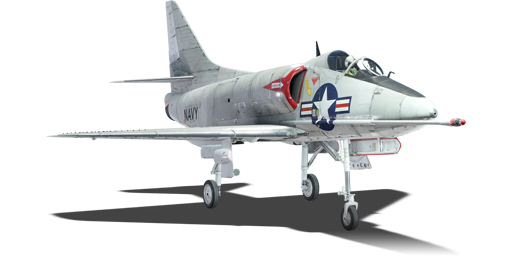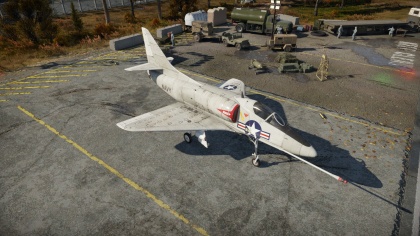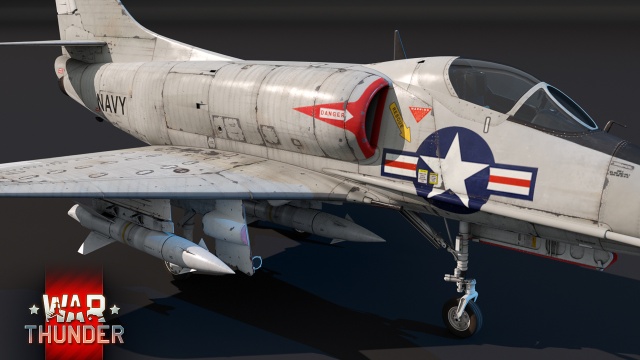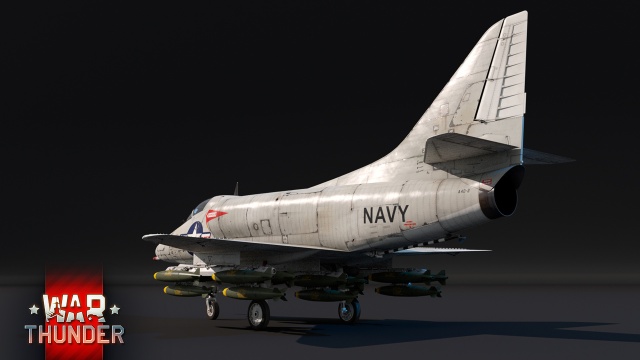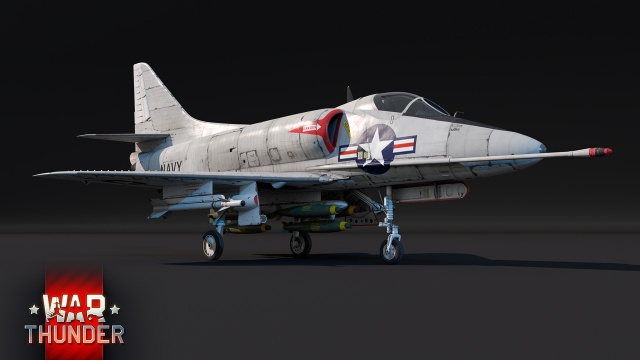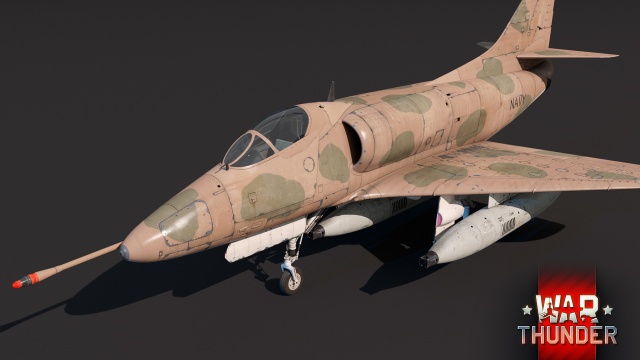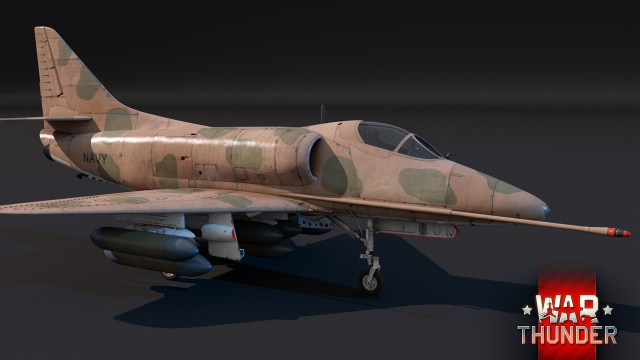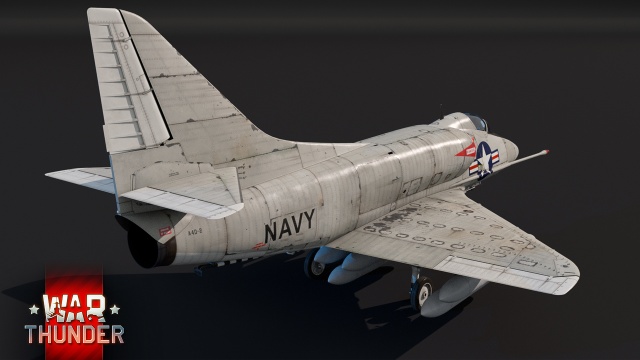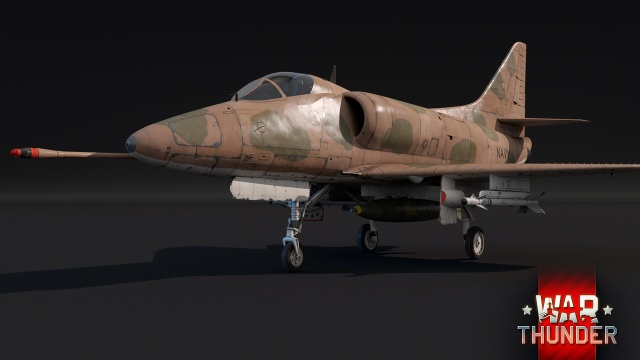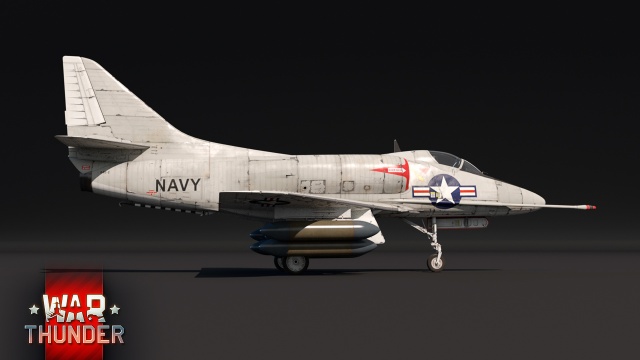A-4B
Contents
Description
The A-4B Skyhawk is a rank VI American jet attacker
with a battle rating of 9.0 (AB/SB) and 8.7 (RB). It was introduced in Update 1.97 "Viking Fury".
General info
Flight performance
Describe how the aircraft behaves in the air. Speed, manoeuvrability, acceleration and allowable loads - these are the most important characteristics of the vehicle.
| Characteristics | Max Speed (km/h at 0 m - sea level) |
Max altitude (metres) |
Turn time (seconds) |
Rate of climb (metres/second) |
Take-off run (metres) | |||
|---|---|---|---|---|---|---|---|---|
| AB | RB | AB | RB | AB | RB | |||
| Stock | 874 | 865 | 12500 | 37.7 | 39.0 | 41.8 | 39.3 | 900 |
| Upgraded | ___ | ___ | __._ | __._ | __._ | __._ | ||
Details
| Features | |||||
|---|---|---|---|---|---|
| Combat flaps | Take-off flaps | Landing flaps | Air brakes | Arrestor gear | Drogue chute |
| ✓ | ✓ | ✓ | ✓ | ✓ | X |
| Limits | ||||||
|---|---|---|---|---|---|---|
| Wings (km/h) | Gear (km/h) | Flaps (km/h) | Max Static G | |||
| Combat | Take-off | Landing | + | - | ||
| 1167 | 437 | 615 | ___ | 410 | ~8 | ~3 |
| Optimal velocities (km/h) | |||
|---|---|---|---|
| Ailerons | Rudder | Elevators | Radiator |
| < 650 | < 700 | < 670 | N/A |
Survivability and armour
The A-4B, designed to be a light-weight attack aircraft was half the weight of the Navy's design spec requirements. This initial weight savings meant that the plane did not have to skimp on pilot protection. Since the primary role of the aircraft is as an attacker, the pilot protection from the front and the underside is critical. From the front, the windshield portion of the canopy contains 50 mm bulletproof glass. Protective armour from the ground or naval based targets comes in the form of a 2.54 mm steel "tub" which the pilot's seat is situated in. The protective shield surrounds the pilot on all four sides (front, back, left and right) and makes up for most of the floor panelling, leaving room for the controls to go through. While the pilot is not invulnerable, the armour will provide a buffer for lighter calibre fire or shrapnel effects from missiles. The pilot does remain vulnerable to fighter aircraft approaching from above the cockpit.
There are three fuel tanks in the aircraft of which the two in the wings are non-self-sealing and pose a fire hazard if they catch on fire, however, the fuel tank situation directly behind the pilot is self-sealing.
- 50 mm bulletproof glass
- 2.54 mm Steel-plated "tub"
- Self-sealing fuel tank behind the pilot
- Non-self-sealing fuel tanks in the wings
Armaments
Offensive armament
The A-4B is outfitted with the following offensive armament:
- 2 x 20 mm Browning-Colt Mk12 Mod 3 autocannons (100 RPG)
Suspended armament
The A-4B can choose from a wide assortment of suspended armament combinations:
- 18 x 250 lb LDGP Mk 81 bombs (4,500 lb total)
- 9 x 500 lb LDGP Mk 82 bombs (4,500 lb total)
- 5 x 1,000 lb LDGP Mk 83 bombs (5,000 lb total)
- 1 x 2,000 lb LDGP Mk 84 bomb (2,000 lb total)
- 3 x AGM-12B Bullpup rockets
- 133 x FFAR Mighty Mouse rockets
- 28 x Zuni Mk32 Mod 0 ATAP rockets
- 2 x AIM-9B Sidewinder Air-to-air missiles
- 76 x FFAR Mighty Mouse rockets + 5 x 500 lb LDGP Mk 82 bombs (2,500 lb total)
- 16 x Zuni Mk32 Mod 0 ATAP rockets + 6 x 250 lb LDGP Mk 81 bombs (1,500 lb total)
- 16 x Zuni Mk32 Mod 0 ATAP rockets + 5 x 500 lb LDGP Mk 82 bombs (2,500 lb total)
- 2 x AIM-9B Sidewinder Air-to-air missiles + 6 x 250 lb LDGP Mk 81 bombs (1,500 lb total)
- 2 x AIM-9B Sidewinder Air-to-air missiles + 5 x 500 lb LDGP Mk 82 bombs (2,500 lb total)
- 2 x AIM-9B Sidewinder Air-to-air missiles + 3 x 1,000 lb LDGP Mk 83 bombs (3,000 lb total)
- 2 x AIM-9B Sidewinder Air-to-air missiles + 1 x 2,000 lb LDGP Mk 84 bomb (2,000 lb total)
- 2 x AIM-9B Sidewinder Air-to-air missiles + 1 AGM-12B Bullpup rocket
- 2 x AIM-9B Sidewinder Air-to-air missiles + 57 FFAR Mighty Mouse rockets
- 2 x AIM-9B Sidewinder Air-to-air missiles + 12 x Zuni Mk32 Mod 0 ATAP rockets
- 3 x 20 mm Mk 11 mod 5 autocannons (750 RPG, 2,250 total rounds)
- 1 x 20 mm Mk 11 mod 5 autocannon (750 RPG) + 2 x AIM-9B Sidewinder Air-to-air missiles
Usage in battles
Describe the tactics of playing in the aircraft, the features of using aircraft in a team and advice on tactics. Refrain from creating a "guide" - do not impose a single point of view, but instead, give the reader food for thought. Examine the most dangerous enemies and give recommendations on fighting them. If necessary, note the specifics of the game in different modes (AB, RB, SB).
Pros and cons
Summarise and briefly evaluate the vehicle in terms of its characteristics and combat effectiveness. Mark its pros and cons in the bulleted list. Try not to use more than 6 points for each of the characteristics. Avoid using categorical definitions such as "bad", "good" and the like - use substitutions with softer forms such as "inadequate" and "effective".
Pros:
Cons:
History
At a time when military aircraft were becoming more substantial in size to hold larger engines, more weapons, essential fuel and new technology, Douglas Aircraft's concept of the A-4 Skyhawk seemed counter-intuitive. The A-1 Skyraider, while a potent aircraft was starting to age out of the service as faster jets began to supplant the propeller-driven attacker. In the early 1950s, the U.S. Navy began its search for the next generation attacker and put out a requirement for an attacker with a maximum cost of $1 million and a maximum empty weight of 20,000 lbs (9,071 kg) and could carry enough ammunition to at least compete with the older but beefy A-1.
Ed Heinemann, a designer at Douglas Aircraft Company, responded with the XA4D-1 attack aircraft. Contrary to conventional wisdom, Heinemann's design focused on an attack aircraft which would be minimal in size and weight along with being a simple aircraft to maintain. Douglas Aircraft succeeded in winning the contract and what became known by nicknames such as "Scooter" or "Bantam Bomber", the XA4D-1 (later changed to A-4) was a winning solution to the Navy's needs. The resulting attack aircraft came in at just over $850,000 each while weighing half of what was the Navy's original specification, owing to weight savings with the wings, being as short as they were, there was no need for them to fold to save space while stowed on an aircraft carrier. "Scooter" was an appropriate nickname for the A-4 as its original prototype set a world speed record in 1955 with a speed of 695.163 mph (1,118.756 km/h).
The A-4 though small in size, did not differ much in design from other military aircraft of the day. The wing was a low-mounted delta shape which had single forge spars which spanned to both wingtips for extra strength. Tricycle configuration for the landing gear allowed the nose to remain relatively low for excellent pilot visibility mainly when operating on the deck of an aircraft carrier. A single turbo-jet engine mounted at the rear of the aircraft was fed by two air intakes located just behind the cockpit on each side of the fuselage. Offensive weapons for this aircraft consisted of two 20 mm Browning-Colt Mk12 Mod 3 autocannons, each one located in a wing root. Only 100 rounds are available for each gun. Still, a single fuselage centerline hardpoint and a hardpoint under each wing allow for utilisation of a wide variety of missiles, rockets, bombs and gun pods.
At the start of the Vietnam War, the A-4 Skyhawk was the primary light bomber for the Navy. A total of 542 A-4Bs were built and delivered to the Navy. Upgrades over the A-4A consisted of improved navigation equipment and flight control systems. AGM-12 Bullpup missiles were also a new weapon for this aircraft. The Skyhawk also utilised the AIM-9B Sidewinder missiles; however, these were mostly used as a defensive weapon and rarely for offensive purposes.
The A-4 is a rugged little attack aircraft which remained in service with both the U.S. Navy and United States Marine Corps for over 20 years before being retired. However, more than sixty years after initial operations began, the Skyhawk is only now still in service with the Brazilian Navy.
Media
- Images
- Videos
See also
Links to the articles on the War Thunder Wiki that you think will be useful for the reader, for example:
- reference to the series of the aircraft;
- links to approximate analogues of other nations and research trees.
External links
| Douglas Aircraft Company | |
|---|---|
| Strike Aircraft | A-20G-25 · A-26B-10 · A-26B-50 · AD-2 · AD-4 · A-1H |
| Bombers | TBD-1 · B-18A · SBD-3 · BTD-1 · A-26C-45 · A-26C-45DT |
| Turboprops | A2D-1 |
| Jet Aircraft | F3D-1 · F4D-1 |
| A-4 Skyhawk | A-4B · A-4E Early |
| Export | ▄Havoc Mk I · ▄Boston Mk I · ▄DB-7 · ▂A-20G-30 · ▄AD-4 · ▄AD-4NA |
| A-4 Skyhawk | A-4H · A-4E Early (M) · Ayit · A-4E |
| The Douglas Aircraft Company merged with McDonnell Aircraft Corporation in 1967 to form McDonnell Douglas. | |
| USA jet aircraft | |
|---|---|
| Fighters | |
| F-4 | F-4C Phantom II · F-4E Phantom II · F-4J Phantom II · F-4S Phantom II |
| F-5 | F-5A · F-5C · F-5E · F-20A |
| F-8 | F8U-2 · F-8E |
| F-80 | F-80A-5 · F-80C-10 |
| F-84 | F-84B-26 · F-84F · F-84G-21-RE |
| F-86 | F-86A-5 · F-86F-25 · F-86F-2 · F-86F-35 |
| F-89 | F-89B · F-89D |
| F-100 | F-100D |
| F-104 | F-104A · F-104C |
| F-14 | F-14A Early · F-14B |
| F-15 | F-15A |
| F-16 | F-16A · F-16A ADF · F-16C |
| F9F | F9F-2 · F9F-5 · F9F-8 |
| Other | P-59A · F2H-2 · F3D-1 · F3H-2 · F4D-1 · F11F-1 |
| Strike Aircraft | |
| FJ-4 | FJ-4B · FJ-4B VMF-232 |
| A-4 | A-4B · A-4E Early |
| A-6 | A-6E TRAM |
| A-7 | A-7D · A-7E · A-7K |
| AV-8 | AV-8A · AV-8C |
| A-10 | A-10A · A-10A Late |
| B-57 | B-57A · B-57B |
| F-105 | F-105D |
| F-111 | F-111A |


